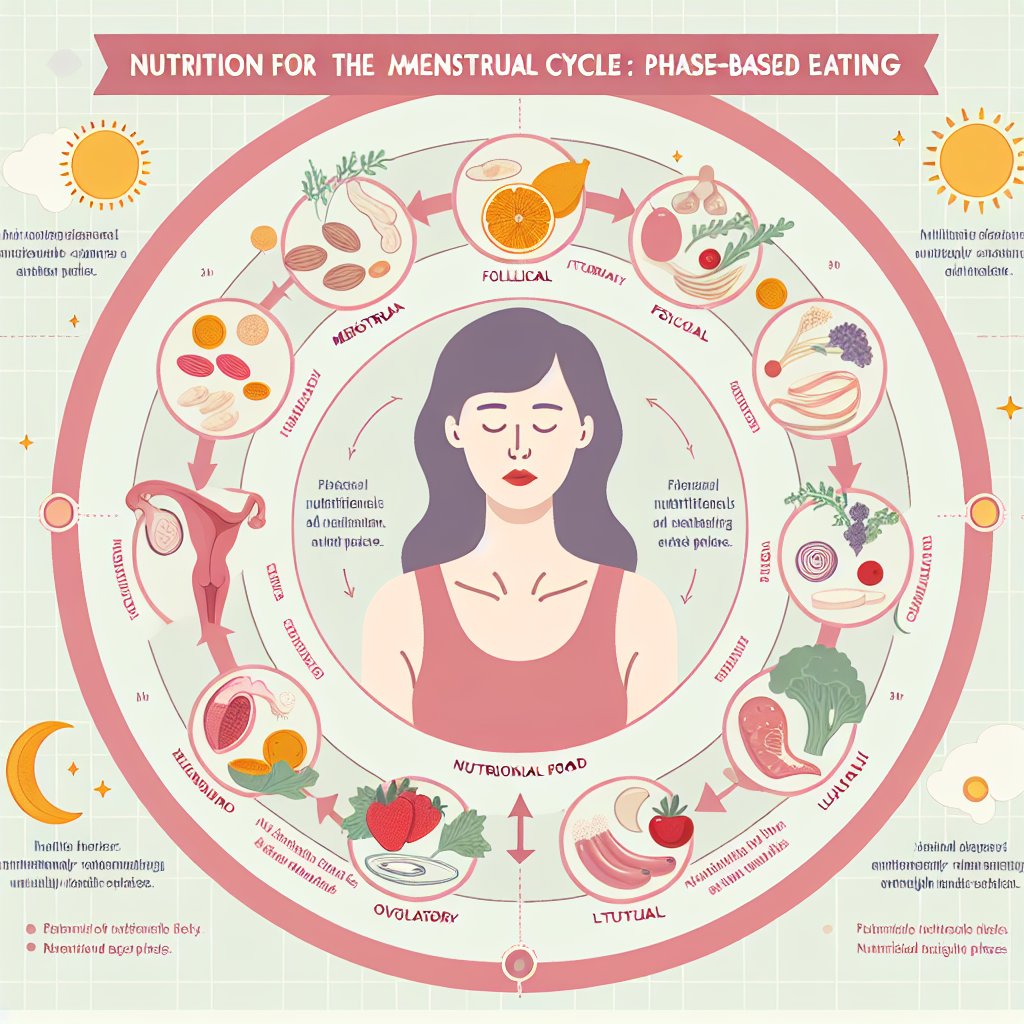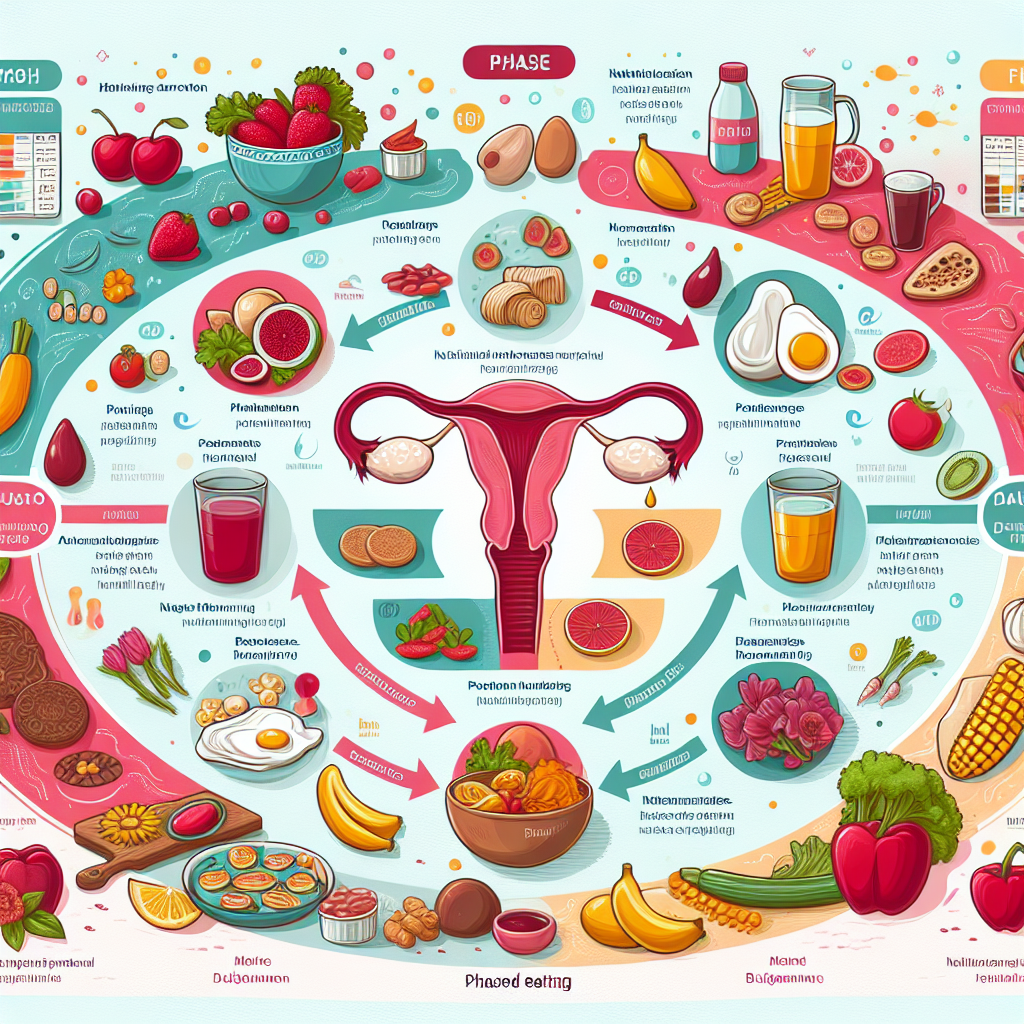Nutrition for the Menstrual Cycle: Phase-Based Eating

Discover the power of phase-based eating for your menstrual cycle. Learn how to optimize your nutrition to support your body’s natural rhythms. Start your journey towards vibrant health today. Click here to learn more.
Understanding Phase-Based Eating: A Guide to Nutrition for the Menstrual Cycle
Understanding phase-based eating is a revolutionary approach to nutrition that tailors dietary choices to the different stages of the menstrual cycle. This method of eating is not just about what you eat, but when you eat it, and it can have profound effects on your overall health, mood, and menstrual symptoms.
The menstrual cycle is divided into four main phases: the menstrual phase, the follicular phase, the ovulation phase, and the luteal phase. Each phase is characterized by different hormonal fluctuations, which can influence your energy levels, mood, and cravings. By aligning your diet with these phases, you can support your body’s natural processes and potentially alleviate some of the discomforts associated with menstruation.
During the menstrual phase, which is when bleeding occurs, your body is in a state of detoxification. It’s a time when you might feel fatigued and crave comfort foods. To support your body during this phase, it’s recommended to consume foods rich in iron and vitamin B12 to replenish lost nutrients. Foods like lean meats, fish, eggs, leafy greens, and whole grains are excellent choices. Hydrating foods like fruits and vegetables can also help to replace lost fluids.
The follicular phase follows menstruation and is a time of renewal and growth. Your body is preparing for the possibility of pregnancy, and estrogen levels are on the rise. This phase calls for foods that support energy production and cell growth. Incorporating high-quality proteins, healthy fats, and plenty of fruits and vegetables into your diet can provide the necessary nutrients. Foods rich in antioxidants, like berries and dark chocolate, can also help to support cell regeneration.
Ovulation is the next phase and is when you’re most fertile. It’s a short but significant phase characterized by a surge in luteinizing hormone, which triggers the release of an egg from the ovary. During ovulation, it’s beneficial to consume foods rich in fiber to help regulate blood sugar levels, which can fluctuate due to increased hormone production. Foods like whole grains, legumes, fruits, and vegetables are ideal.
The final phase, the luteal phase, is when progesterone levels rise and the body prepares for either pregnancy or the start of a new cycle. This phase can often bring about symptoms of premenstrual syndrome (PMS), including bloating, mood swings, and cravings for sweet or salty foods. To combat these symptoms, it’s recommended to eat foods rich in B vitamins, calcium, and magnesium, such as leafy greens, nuts, seeds, and dairy products. Consuming small, frequent meals can also help to stabilize blood sugar levels and manage cravings.
Phase-based eating is a holistic approach to nutrition that takes into account the unique needs of the female body throughout the menstrual cycle. It’s about nourishing your body with the right foods at the right times to support hormonal balance, energy production, and overall well-being. While it may require a bit of planning and awareness, the potential benefits to your health and comfort during your menstrual cycle make it worth considering. As with any dietary changes, it’s always best to consult with a healthcare professional or a registered dietitian to ensure that you’re meeting all of your nutritional needs.
The Role of Nutrition in Each Phase of the Menstrual Cycle: A Deep Dive into Phase-Based Eating

The menstrual cycle is a natural process that women experience every month, and it can significantly impact their physical and emotional well-being. One aspect of health that can greatly influence the menstrual cycle is nutrition. Phase-based eating, a concept that involves tailoring your diet to each phase of the menstrual cycle, has gained traction in recent years. This approach can help alleviate menstrual symptoms, balance hormones, and promote overall health.
The menstrual cycle is divided into four phases: the menstrual phase, the follicular phase, the ovulation phase, and the luteal phase. Each phase is characterized by different hormonal changes, which can be supported by specific nutrients.
During the menstrual phase, which is when bleeding occurs, the body needs foods rich in iron to compensate for the loss of blood. Consuming lean meats, leafy green vegetables, and legumes can help replenish iron stores. Additionally, foods high in vitamin C, such as citrus fruits and bell peppers, can enhance iron absorption.
Following the menstrual phase is the follicular phase. This phase is characterized by the maturation of follicles in the ovaries, stimulated by the hormone estrogen. Foods rich in antioxidants, like berries, nuts, and seeds, can support follicle health. Moreover, incorporating whole grains and lean proteins can provide the body with the energy it needs during this phase.
The ovulation phase is the next stage, and it’s when the mature egg is released from the ovary. This phase requires a diet rich in fiber to help regulate estrogen levels. Foods like whole grains, fruits, and vegetables are excellent sources of fiber. Additionally, consuming foods high in vitamin B, such as eggs, fish, and leafy greens, can support the production of progesterone, a hormone that prepares the uterus for potential pregnancy.
The final phase is the luteal phase, which is characterized by a rise in progesterone levels. If the egg is not fertilized, progesterone levels drop, leading to the shedding of the uterine lining and the start of the menstrual phase. During this phase, women often experience premenstrual syndrome (PMS) symptoms, such as bloating, mood swings, and cravings. Consuming foods rich in magnesium, like dark chocolate, bananas, and avocados, can help alleviate these symptoms. Additionally, foods high in vitamin B6, like poultry, fish, and whole grains, can help regulate mood and reduce water retention.
Phase-based eating is not a one-size-fits-all approach, and individual needs may vary. It’s important to listen to your body and adjust your diet accordingly. Moreover, maintaining a balanced diet throughout the cycle, rich in fruits, vegetables, lean proteins, and whole grains, is crucial for overall health.
In conclusion, nutrition plays a pivotal role in each phase of the menstrual cycle. By tailoring your diet to support the hormonal changes that occur during each phase, you can help alleviate menstrual symptoms, balance hormones, and promote overall health. Phase-based eating is a powerful tool that can empower women to take control of their menstrual health through nutrition.
Phase-Based Eating: How to Optimize Your Nutrition for Every Stage of the Menstrual Cycle
The menstrual cycle is a natural process that every woman experiences, and it can significantly impact her overall health and well-being. One aspect of health that is often overlooked in relation to the menstrual cycle is nutrition. However, research suggests that phase-based eating, or tailoring your diet to each stage of your menstrual cycle, can help optimize your nutrition and alleviate some of the symptoms associated with menstruation.
The menstrual cycle is divided into four main phases: the menstrual phase, the follicular phase, the ovulation phase, and the luteal phase. Each phase is characterized by different hormonal changes, which can influence your energy levels, mood, and cravings. By understanding these changes and adjusting your diet accordingly, you can support your body’s needs and promote better health.
During the menstrual phase, which is when bleeding occurs, your body is shedding the uterine lining. This process can lead to feelings of fatigue and discomfort. To combat these symptoms, it’s recommended to consume foods rich in iron and vitamin B12, such as lean meats, leafy green vegetables, and fortified cereals. These nutrients can help replenish the blood lost during menstruation and boost your energy levels.
Next is the follicular phase, which begins after menstruation and lasts until ovulation. During this phase, estrogen levels rise, which can increase your energy levels and metabolism. To support this phase, it’s beneficial to consume a diet rich in proteins and fiber. Foods like eggs, chicken, fish, beans, and whole grains can provide the necessary nutrients to maintain energy and promote healthy digestion.
The ovulation phase is when the body is preparing for potential pregnancy. This phase is characterized by a surge in luteinizing hormone, which can lead to increased cravings. To manage these cravings and maintain balanced blood sugar levels, it’s recommended to consume complex carbohydrates like whole grains, fruits, and vegetables. Additionally, consuming foods rich in vitamin E and omega-3 fatty acids, such as nuts, seeds, and fatty fish, can support hormone production and promote overall health.
Finally, the luteal phase occurs after ovulation and before the start of menstruation. During this phase, progesterone levels rise, which can lead to symptoms like bloating, mood swings, and cravings for comfort foods. To alleviate these symptoms, it’s beneficial to consume foods rich in magnesium and vitamin B6, such as bananas, avocados, and dark chocolate. These nutrients can help reduce water retention and improve mood.
In conclusion, phase-based eating is a powerful tool that can help you optimize your nutrition for every stage of the menstrual cycle. By understanding the hormonal changes that occur during each phase and adjusting your diet accordingly, you can support your body’s needs, alleviate menstrual symptoms, and promote better health. However, it’s important to remember that everyone’s body is different, and what works for one person may not work for another. Therefore, it’s always recommended to consult with a healthcare professional before making any significant changes to your diet.